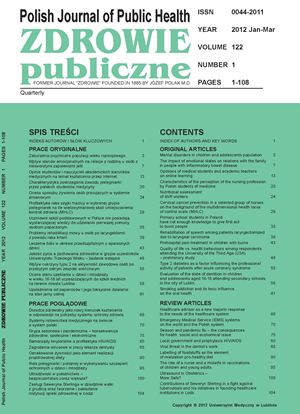Opinie studentów i nauczycieli akademickich kierunków medycznych na temat kształcenia przez Internet
Słowa kluczowe:
kształcenie na odległość, blended-learning, uczelnia medyczna, nowoczesne metody kształceniaAbstrakt
Wstęp. Kształcenie przez Internet wprowadzane jest w coraz większej liczbie uczelni kształcących specjalistów ochrony zdrowia.
Cel. Celem pracy była analiza opinii studentów i pracowników naukowo-dydaktycznych na temat wprowadzenia kształcenia przez Internet.
Materiał i metody. Dobrowolne, anonimowe badania ankietowe przeprowadzono wśród 1528 studentów oraz 128 nauczycieli akademickich w Warszawskim Uniwersytecie Medycznym.
Wyniki. Podczas nauki z komputera korzysta 53% studentów, a 74% przed przystąpieniem do nauki w systemie e-learningu nie potrzebuje szkolenia. Internet wykorzystuje w celach dydaktycznych 55% wykładowców, a 65% przekazuje studentom materiały z zajęć. W zajęciach przez Internet chciałoby wziąć udział 58% studentów, a 54% nauczycieli byłaby zainteresowana przeprowadzeniem takich zajęć (p=NS).
Wnioski. Obecnie zdecydowana większość studentów korzysta z Internetu podczas nauki, zatem są oni od strony technicznej przygotowani do stosowania w dydaktyce metod kształcenia na odległość. Należy podnosić kompetencje studentów platform e-lerningowych tak, aby niedostatek umiejętności studentów w tym zakresie nie utrudniał prowadzenia zajęć dydaktycznych. W uczelniach o profilu medycznym wprowadzanie nowych metod kształcenia przez Internet należy rozpoczynać od zajęć z zakresu przedmiotów ogólnouniwersyteckich realizowanych w trybie wykładów i seminariów.
Bibliografia
1. Wilkinson A, While AE, Roberts J. Measurement of information and communication technology experience and attitudes to e-learning of students in the healthcare professions: integrative review. J Adv Nurs. 2009;65(4):755-72.
2. Booth A, Carroll C, Papaioannou D, Sutton A, Wong R. Applying findings from a systematic review of workplace-based e-learning: implications for health information professionals. Health Info Libr J. 2009;26(1):4-21.
3. Lee TS, Kuo MH, Borycki EM, Yunyong D. Critical success factors for implementing healthcare e-Learning. Stud Health Technol Inform. 2011;164:64-8.
4. Moule P, Ward R, Lockyer L. Nursing and healthcare students’ experiences and use of e-learning in higher education. J Adv Nurs. 2010;66(12):2785-95.
5. Luke R, Solomon P, Baptiste S, Hall P, Orchard C, Rukholm E, Carter L. Online interprofessional health sciences education: From theory to practice. J Contin Educ Health Prof. 2009;29(3):161-7.
6. Hege I, Ropp V, Adler M, Radon K, Mäsch G, Lyon H, Fischer MR. Experiences with different integration strategies of case-based e-learning. Med Teach. 2000;29(8):791-7.
7. Białoszewski D, Kasperska K, Gotlib J. Tradycja i/czy nowoczesność? Nauczanie na odległość wyzwaniem dla kształcenia studentów kierunków medycznych. Medycyna Dydaktyka Wychowanie; 2011; 2:36-40.
8. Bilski D. Potrzeby, możliwości i metody kształcenia w zakresie orzecznictwa lekarskiego. Orzecz Lek. 2008;5(1):11-7.
9. Cisek Maria, Górkiewicz M, Brzostek T. Polish on-line resources for community nurses. Rocz AM Białyst. 2005;50(suppl. 2):59-60.
10. Sobański Jerzy A, Klasa K. Distant psychotherapy learning. Leonardo da Vinci – SEPTIMUS programme. Arch Psychiatr Psychother. 2004;6(3):89-99.
11. Szosland D, Marcinkiewicz A. Modern technology in lifelong learning of occupational medicine. Int J Occup Med Environ Health. 2004;17(4):411-6.
12. Marcinkiewicz A, Cybart A, Chromińska-Szosland D, Nosko J. Nowe formy kształcenia w medycynie pracy. Med Pr. 2003:54(6):573-8.
13. Marcinkiewicz A, Cybart A, Chromińska-Szosland D. Możliwości wykorzystania metod distance learning do podyplomowego kształcenia lekarzy na przykładzie specjalizacji z medycyny pracy. Wiad Lek. 2002:55:330-4.
14. Michowska M. E-learning i jego wykorzystanie w nauczaniu etyki In: Nauczanie etyki w uczelniach medycznych. Gdańsk; 2007. p.169-73.
15. Hippe Zdzisław S, Paszczyński S. Zdalne nauczanie i zdalne uczenie się w medycynie. Telemedycyna 2001: II Krajowa Konferencja Naukowa. Łódź; 2001. p.5-9.
16. Oehlsen A, Baer-Dubowska W. E-learning : TellRight - providing language competence for medics online (LEONARDO Programme) In: International Conference “Medical Education in Central and Eastern Europe – from status quo to changes. Poznań; 2005. p.73-9.
17. Brodziak A, Piotrowska E. Zdalne wspomaganie nauczania poprzez Internet – nowe narzędzie nauczyciela akademickiego – doświadczenia własne. Ann Acad Me Siles. 2001;48/49:45-51.
18. Fusilier M, Durlabhji S, Cucchi A, Collins M. A four-country investigation of factors facilitating student internet use. Cyberpsychol Behav. 2005;8(5):454-64.
19. Ceyhan AA. Predictors of problematic Internet use on Turkish university students. Cyberpsychol Behav. 2008;11(3):363-6.
20. Castelló Castañeda C, Ríos Santos JV, Bullón P. Analysis of the knowledge and opinions of students and qualified dentists regarding the use of computers. Med Oral Patol Oral Cir Bucal. 2008;13(1):E71-6.
21. Hanauer D, Dibble E, Fortin J, Col NF. Internet use among community college students: implications in designing healthcare interventions. J Am Coll Health. 2004;52(5):197-202.
22. Palesh O, Saltzman K, Koopman C. Internet use and attitudes towards illicit internet use behavior in a sample of Russian college students. Cyberpsychol Behav. 2004;7(5):553-8.
23. Rzymski P, Wilczak M, Pieta B, Opala T, Woźniak J. Evaluation of internet use in university education by midwifery students. Med Inform Internet Med. 2006 ;31(3):219-25.
24. Peterson D, Kaakko T, Smart E, Jorgenson M, Herzog C. Dental students attitudes regarding online education in pediatric dentistry. J Dent Child (Chic). 2007;74(1):10-20.
25. Uribe S, Mariño RJ.Internet and information technology use by dental students in Chile. Eur J Dent Educ. 2006;10(3):162-8.
26. Ayatollahi J, Ayatollahi F, Bahrololoomi R. Using the internet among dental students in Yazd. Dent Res J (Isfahan). 2010;7(1):7-11.
27. Joiner R, Gavin J, Duffield J, Brosnan M, Crook C, Durndell A, Maras P, Miller J, Scott AJ, Lovatt P. Gender, Internet identification, and Internet anxiety: correlates of Internet use. Cyberpsychol Behav. 2005;8(4): 371-8.


